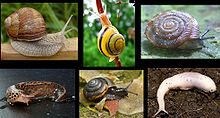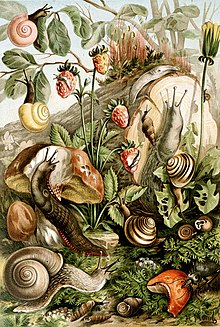Pulmonata
| Pulmonata Temporal range:
| |
|---|---|

| |
| Various examples of Pulmonata | |
| Scientific classification | |
| Domain: | Eukaryota |
| Kingdom: | Animalia |
| Phylum: | Mollusca |
| Class: | Gastropoda |
| Subclass: | Heterobranchia |
| Informal group: | Pulmonata Cuvier,1814 |
| Taxonomic subdivisions | |
| |
Pulmonataorpulmonatesis an informal group (previously anorder,and before that, asubclass) ofsnailsandslugscharacterized by the ability to breathe air, by virtue of having apallial lunginstead of agill,or gills. The group includes many land and freshwater families, and several marine families.
ThetaxonPulmonata as traditionally defined was found to bepolyphyleticin a molecular study per Jörgeret al.,dating from 2010.[1]
Pulmonata are known from theCarboniferousperiod to the present.[2]
Pulmonates have a singleatriumand kidney, and a concentrated symmetrical nervous system. The mantle cavity is on the right side of the body, and lacks gills, instead being converted into avascularisedlung. Most species have a shell, but nooperculum,although the group does also include several shell-less slugs. Pulmonates arehermaphroditic,and some groups possesslove darts.[3]
Linnean taxonomy
[edit]The taxonomy of this group according to thetaxonomy of the Gastropoda (Ponder & Lindberg, 1997)was as follows:
OrderPulmonataCuvierin Blainville, 1814 - pulmonates
- SuborderSystellommatophoraPilsbry, 1948
- SuperfamilyOnchidioideaRafinesque,1815
- SuperfamilyOtinoideaH. & A. Adams, 1855
- SuperfamilyRathouisioideaSarasin, 1889
- SuborderBasommatophoraKeferstein in Bronn, 1864 - freshwater pulmonates, pond snails
- SuperfamilyAcroloxoideaThiele,1931
- SuperfamilyAmphiboloideaJ.E. Gray,1840
- SuperfamilyChilinoideaH. & A. Adams, 1855
- SuperfamilyGlacidorboideaPonder, 1986
- SuperfamilyLymnaeoideaRafinesque,1815
- SuperfamilyPlanorboideaRafinesque,1815
- SuperfamilySiphonarioideaJ.E. Gray,1840
- SuborderEupulmonataHaszprunar & Huber, 1990
- InfraorderActeophilaDall,1885 = formerly Archaeopulmonata
- SuperfamilyMelampoideaStimpson, 1851
- InfraorderTrimusculiformesMinichev & Starobogatov, 1975
- SuperfamilyTrimusculoideaZilch, 1959
- InfraorderActeophilaDall,1885 = formerly Archaeopulmonata


- InfraorderStylommatophoraA. Schmidt, 1856 - land snails
- SubinfraorderOrthurethra
- SuperfamilyAchatinelloideaGulick, 1873
- SuperfamilyCochlicopoideaPilsbry, 1900
- SuperfamilyPartuloideaPilsbry, 1900
- SuperfamilyPupilloideaTurton, 1831
- SubinfraorderSigmurethra
- SuperfamilyAcavoideaPilsbry, 1895
- SuperfamilyAchatinoideaSwainson, 1840
- SuperfamilyAillyoideaBaker, 1960
- SuperfamilyArionoideaJ.E. Grayin Turnton, 1840
- SuperfamilyBuliminoideaClessin, 1879
- SuperfamilyCamaenoideaPilsbry, 1895
- SuperfamilyClausilioideaMörch,1864
- SuperfamilyDyakioideaGude & Woodward, 1921
- SuperfamilyGastrodontoideaTryon, 1866
- SuperfamilyHelicoideaRafinesque,1815
- SuperfamilyHelixarionoideaBourguignat, 1877
- SuperfamilyLimacoideaRafinesque,1815
- SuperfamilyOleacinoideaH. & A. Adams, 1855
- SuperfamilyOrthalicoideaAlbers-Martens, 1860
- SuperfamilyPlectopylidoideaMoellendorf, 1900
- SuperfamilyPolygyroideaPilsbry, 1894
- SuperfamilyPunctoideaMorse, 1864
- SuperfamilyRhytidoideaPilsbry, 1893
- SuperfamilySagdidoideraPilsbry, 1895
- SuperfamilyStaffordioideaThiele,1931
- SuperfamilyStreptaxoideaJ.E. Gray,1806
- SuperfamilyStrophocheiloideaThiele,1926
- SuperfamilyTrigonochlamydoideaHese, 1882
- SuperfamilyZonitoideaMörch,1864
- ?SuperfamilyAthoracophoroideaP. Fischer, 1883 = Tracheopulmonata
- ?SuperfamilySuccineoideaBeck, 1837 = Heterurethra
- InfraorderStylommatophoraA. Schmidt, 1856 - land snails
2005 taxonomy
[edit]
The taxonomy of this group according to thetaxonomy of the Gastropoda (Bouchet & Rocroi, 2005)[4]was as follows:
Informal Group Pulmonata
[edit]Contains the informal groupBasommatophoraand the cladeEupulmonata
Informal Group Basommatophora
[edit]Contains the cladeHygrophila
- SuperfamilyAmphiboloidea
- FamilyAmphibolidae
- SuperfamilySiphonarioidea
- FamilySiphonariidae
- † FamilyAcroreiidae
CladeHygrophila
[edit]- SuperfamilyChilinoidea
- FamilyChilinidae
- FamilyLatiidae
- SuperfamilyAcroloxoidea
- FamilyAcroloxidae
- SuperfamilyLymnaeoidea
- FamilyLymnaeidae
- SuperfamilyPlanorboidea
- FamilyPlanorbidae
- FamilyPhysidae
Clade Eupulmonata
[edit]Contains the cladesSystellommatophoraandStylommatophora
- SuperfamilyTrimusculoidea
- FamilyTrimusculidae
- SuperfamilyOtinoidea
- FamilyOtinidae
- FamilySmeagolidae
- SuperfamilyEllobioidea
- FamilyEllobiidae
CladeSystellommatophora( =Gymnomorpha)
[edit]- SuperfamilyOnchidioidea
- FamilyOnchidiidae
- SuperfamilyVeronicelloidea
- FamilyVeronicellidae
- FamilyRathouisiidae
CladeStylommatophora
[edit]Contains the subcladesElasmognatha,Orthurethraand the informal groupSigmurethra
SubcladeElasmognatha
[edit]- SuperfamilySuccineoidea
- FamilySuccineidae
- SuperfamilyAthoracophoroidea
- FamilyAthoracophoridae
SubcladeOrthurethra
[edit]- SuperfamilyPartuloidea
- FamilyPartulidae
- FamilyDraparnaudiidae
- SuperfamilyAchatinelloidea
- FamilyAchatinellidae
- SuperfamilyCochlicopoidea
- FamilyCochlicopidae
- FamilyAmastridae
- SuperfamilyPupilloidea
- FamilyPupillidae
- FamilyArgnidae
- FamilyChondrinidae
- † FamilyCylindrellinidae
- FamilyLauriidae
- FamilyOrculidae
- FamilyPleurodiscidae
- FamilyPyramidulidae
- FamilySpelaeodiscidae
- FamilyStrobilopsidae
- FamilyValloniidae
- FamilyVertiginidae
- SuperfamilyEnoidea
- FamilyEnidae
- FamilyCerastidae
Informal GroupSigmurethra
[edit]- SuperfamilyClausilioidea
- FamilyClausiliidae
- † FamilyAnadromidae
- † FamilyFilholiidae
- † FamilyPalaeostoidae
- SuperfamilyOrthalicoidea
- FamilyOrthalicidae
- FamilyCerionidae
- FamilyCoelociontidae
- † FamilyGrangerellidae
- FamilyMegaspiridae
- FamilyPlacostylidae
- FamilyUrocoptidae
- SuperfamilyAchatinoidea
- FamilyAchatinidae
- FamilyFerussaciidae
- FamilyMicractaeonidae
- FamilySubulinidae
- SuperfamilyAillyoidea
- FamilyAillyidae
- SuperfamilyTestacelloidea
- FamilyTestacellidae
- FamilyOleacinidae
- FamilySpiraxidae
- SuperfamilyPapillodermatoidea
- FamilyPapillodermatidae
- SuperfamilyStreptaxoidea
- FamilyStreptaxidae
- SuperfamilyRhytidoidea
- FamilyRhytididae
- FamilyChlamydephoridae
- FamilyHaplotrematidae
- FamilyScolodontidae
- SuperfamilyAcavoidea
- FamilyAcavidae
- FamilyCaryodidae
- FamilyDorcasiidae
- FamilyMacrocyclidae
- FamilyMegomphicidae
- FamilyStrophocheilidae
- SuperfamilyPunctoidea
- FamilyPunctidae
- † FamilyAnastomopsidae
- FamilyCharopidae
- FamilyCystopeltidae
- FamilyDiscidae
- FamilyEndodontidae
- FamilyHelicodiscidae
- FamilyOreohelicidae
- FamilyThyrophorellidae
- SuperfamilySagdoidea
- FamilySagdidae
- SuperfamilyStaffordioidea
- FamilyStaffordiidae
- Superfamily Dyakioidea
- FamilyDyakiidae
- SuperfamilyGastrodontoidea
- FamilyGastrodontidae
- FamilyChronidae
- FamilyEuconulidae
- FamilyOxychilidae
- FamilyPristilomatidae
- FamilyTrochomorphidae
- Fossil taxa probably belonging to the Gastrodontoidea
- Subfamily † Archaeozonitinae
- Subfamily † Grandipatulinae
- Subfamily † Palaeoxestininae
- SuperfamilyParmacelloidea
- FamilyParmacellidae
- FamilyMilacidae
- FamilyTrigonochlamydidae
- SuperfamilyZonitoidea
- FamilyZonitidae
- SuperfamilyHelicarionoidea
- FamilyHelicarionidae
- FamilyAriophantidae
- FamilyUrocyclidae
- SuperfamilyLimacoidea
- FamilyLimacidae
- FamilyAgriolimacidae
- FamilyBoettgerillidae
- FamilyVitrinidae
other Sigmurethra
[edit]Two superfamilies belongs to clade Sigmurethra, but they are not in the limacoid clade.
- SuperfamilyArionoidea
- FamilyArionidae
- FamilyAnadenidae
- FamilyAriolimacidae
- FamilyBinneyidae
- FamilyOopeltidae
- FamilyPhilomycidae
- SuperfamilyHelicoidea
- FamilyHelicidae
- FamilyBradybaenidae
- FamilyCamaenidae
- FamilyCepolidae
- FamilyCochlicellidae
- FamilyElonidae
- FamilyEpiphragmophoridae
- FamilyHalolimnohelicidae
- FamilyHelicodontidae
- FamilyHelminthoglyptidae
- FamilyHumboldtianidae
- FamilyHygromiidae
- FamilyMonadeniidae
- FamilyPleurodontidae
- FamilyPolygyridae
- FamilySphincterochilidae
- FamilyThysanophoridae
- FamilyTrissexodontidae
- FamilyXanthonychidae
2010 taxonomy
[edit]Jörgeret al.(2010)[1]analyzed major groups within theHeterobranchiausing genetic data and found that Pulmonata as traditionally defined waspolyphyletic,for instance some pulmonates were more closely related toSacoglossaandAcochlidia.They proposed the more inclusive taxonPanpulmonatato unite the cladesSiphonarioidea,Sacoglossa,Glacidorboidea,Pyramidelloidea,Amphiboloidea,Hygrophila,AcochlidiaandEupulmonata.[1]
References
[edit]- ^abcJörger, Katharina M; Stöger, Isabella; Kano, Yasunori; Fukuda, Hiroshi; Knebelsberger, Thomas; Schrödl, Michael (2010)."On the origin of Acochlidia and other enigmatic euthyneuran gastropods, with implications for the systematics of Heterobranchia".BMC Evolutionary Biology.10(1): 323.Bibcode:2010BMCEE..10..323J.doi:10.1186/1471-2148-10-323.PMC3087543.PMID20973994.
- ^(in Czech) Pek I., Vašíček Z., Roček Z., Hajn. V. & Mikuláš R. 1996.Základy zoopaleontologie.Olomouc, 264 pp.,ISBN80-7067-599-3.
- ^Barnes, Robert D. (1982).Invertebrate Zoology.Philadelphia, PA: Holt-Saunders International. p. 377.ISBN0-03-056747-5.
- ^Bouchet, Philippe;Rocroi, Jean-Pierre;Frýda, Jiri; Hausdorf, Bernard;Ponder, Winston;Valdés, Ángel & Warén, Anders (2005). "Classification and nomenclator of gastropod families".Malacologia.47(1–2). Hackenheim, Germany: ConchBooks: 1–397.ISBN3-925919-72-4.ISSN0076-2997.
Further reading
[edit]- Wade, C. M.; Mordan, P. B.; Clarke, B. (2001)."A phylogeny of the land snails (Gastropoda: Pulmonata)".Proceedings of the Royal Society B: Biological Sciences.268(1465): 413–422.doi:10.1098/rspb.2000.1372.PMC1088622.PMID11270439.
- Holznagel, W. E.; Colgan, D. J.; Lydeard, C. (2010). "Pulmonate phylogeny based on 28S rRNA gene sequences: A framework for discussing habitat transitions and character transformation".Molecular Phylogenetics and Evolution.57(3): 1017–1025.Bibcode:2010MolPE..57.1017H.doi:10.1016/j.ympev.2010.09.021.PMID20920591.
